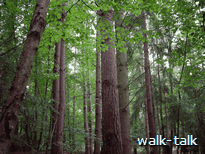

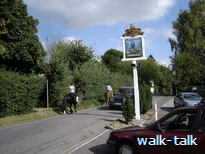
Directly opposite The Woodman pub sign
is a gap in the hedge.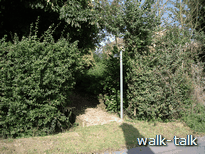
This
is the entrance to “Footpath 21 White Stubbs Lane ½”,
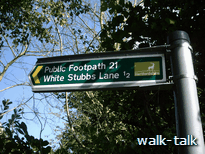
a tunnel between hedges;
pines on the right and,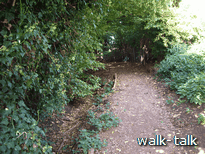
on the left,
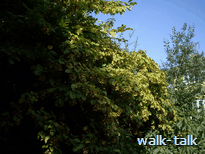 seed-laden hornbeams
seed-laden hornbeams
and a steep ditch with
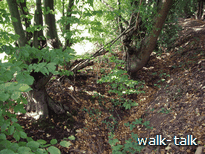 some ancient hornbeams
some ancient hornbeams
showing the distortions of long-ago laying.
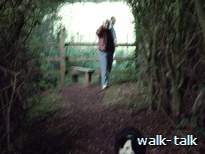
We soon come to a stile, and there I met the lady owner of the farm through which runs this path. She explained that the path has recently (2007) been re-surfaced and the edge by the ditch strengthened to enable disabled access.
To achieve the same objective, the stile will have to go.
For now, we cross the stile on to a path fenced off from a meadow.
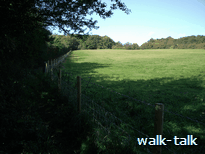
The farm owner explained that they had had to fence the path from the meadow because insurance is expensive and people were playing football on the field and even barbequing on a small unstable device the week before the dry hay was due to be cut. Her message to us all is "Please stay on the public rights of way and respect the property on either side."
There are autumn leaves from pink to magenta and glossy
plump crimson rosehips in the hedge on our left:
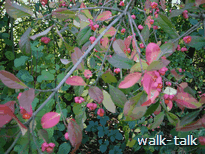
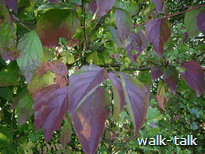
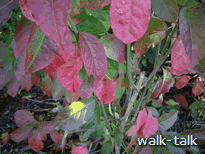
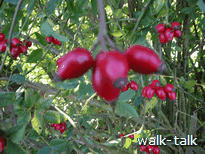
To catch our breath as we climb the hill, we pause to savour
the long views behind us.
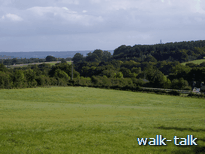
We shall be coming back this way, but who knows how the weather will change and it would be a shame not to grasp every opportunity of feeling on top of the world.
At the top of the hill, we go through a metal kissing gate
into Emanuel Pollards,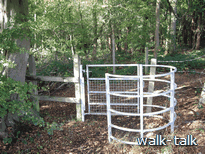 a fragment of woodland on the east of West End Lane.
a fragment of woodland on the east of West End Lane.
It is worth having a good look round at how it will look on the way back so that we can be sure to turn here:
note the wooden sign
pointing
back to The Woodman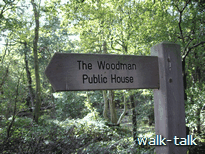 ,
,
the strangely looped hornbeam branch
above the kissing gate,
and the butterfly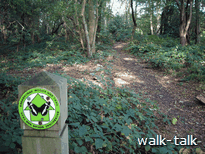 waymark that we shall see a lot of now as
it marks the National Nature Reserve (NNR) trail that we shall be following.
waymark that we shall see a lot of now as
it marks the National Nature Reserve (NNR) trail that we shall be following.
We go right, following the direction of the butterfly waymark.
We cross a wooden slat presumably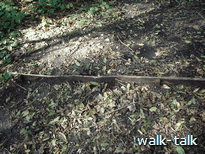 placed to stop soil being washed away down
hill.
placed to stop soil being washed away down
hill.
It is another marker for us on our return.
It tells us that we are near the kissing gate where we turn to go out of the woods.
We are in coppiced hornbeam woodland
with a carpet of autumn leaves at our feet.
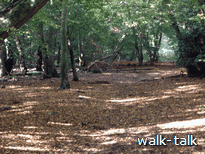
The faint grey upwards striations on the bark,
the horizontal lift of the fine branches and the lightness of leaves make the woods ethereal.
The delicacy of the leaves is
accentuated by the doily effect of worm holes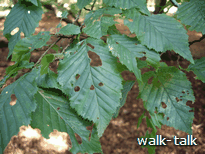 .
.
When we go walking in hornbeam woods in early spring - at bluebell time - we come away with tiny caterpillars in our hair, on our collar and on our shoulders. We see here the result of the caterpilars' summer of munching.
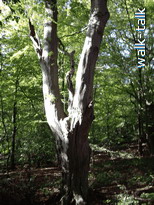
Some of the trees are old and un-hornbeam like:
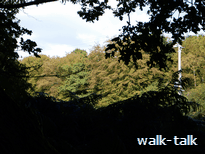
The path bears left so that we are walking along the eastern edge of the woods and can see, beyond the edge of the tree line, a meadow - and beyond the meadow, a magnificent bank of trees.
There
is a dry pond on our right,
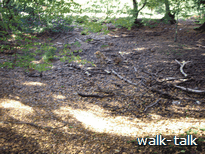 between the path and the edge of the wood.
between the path and the edge of the wood.
The white birch logs in it look to me like long thin bones
and I am reminded of elephant bones bleached by an African sun.
The site of such bones seems to distress elephants
and they pause to examine them,
gently touching the bones with the tips of their trunks.
I am minded, too, of the pretty damsel and dragon flies,
the newts and wetland flora that must have thrived here.
It has been a wet summer (2007).
Why is there not more water in the ponds and brooklets?
Soon after the dry pond we come, on the right hand side of the path, to
a wooden board
(TL 336065). It is facing
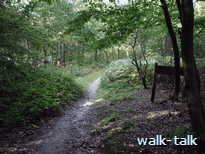 the wrong way for us to read what is on it.
the wrong way for us to read what is on it.
As we pass it, we read
“Emanuel Pollards”
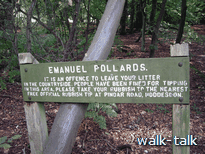 and some more information about these woodlands.
and some more information about these woodlands.
We see, also, the next butterfly waymark, which points
us to the left.
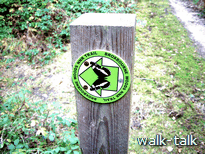
Is this area of woodland so named because the trees were pollarded? There are two oaks that have spreading branches above a certain level but surely too high a level for easy pollarding. Can you see any trees that look as if they might have been pollarded? It seems more likely that the woods were named for a man called Emanuel Pollards.
We are walking west now, close to White Stubbs Lane, which is on our right. Very soon there is another reassuring butterfly waymark.
We come out on to West End Road, which runs to our left. White Stubbs Lane is on our right.
We have reached point 2 on our map TL 335065.